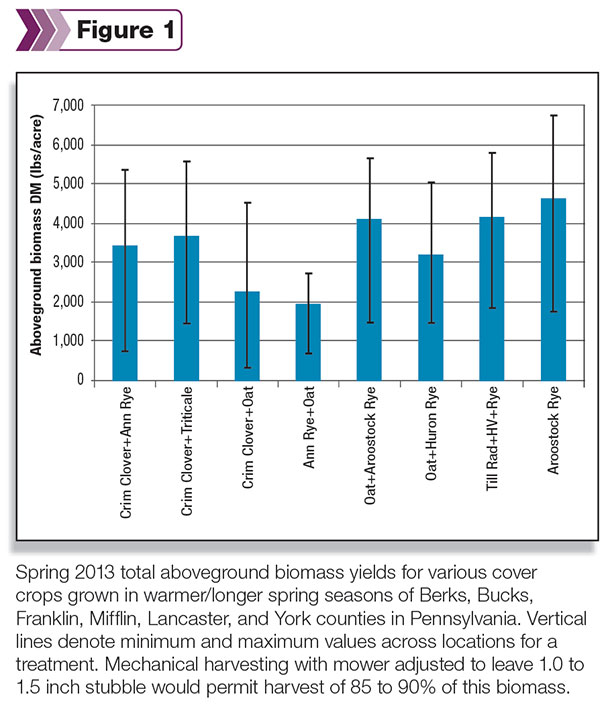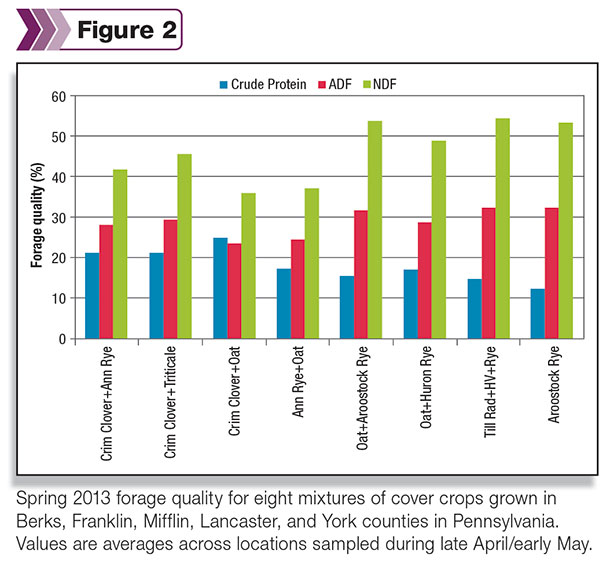Further, regardless of growing-season moisture, are there modifications to cropping systems that can allow dairymen to squeeze more production from each of their acres?
The good growing seasons for much of the Northeast during 2013 and 2014 are making the 2012 drought a distant memory. As a result, there may be little interest in even considering changes to dairy forage production programs.
But what happens when we experience a repeat of the droughts of recent years and corn silage yields are reduced some 25 to 50 percent or more, and silage quality falls even further due to poor grain fill?
Until weather predictions become more accurate, we will have to accept the fact that a certain amount of risk will continue to be associated with cropping programs that only perform well in the absence of weather extremes.
Do we simply accept this risk and do nothing to reduce it? If we want to reduce that risk, what are some options?
Agronomists recognize that yield potential from an acre of dairy cropland can be below optimum when one or more of the following conditions occur:
1. Precipitation is below optimum.
2. The intended crop is not well matched to a particular soil type.
3. There are times during the year when a different or additional crop could be grown to make use of available resources, especially sunshine and fertility nutrients.
Unless irrigation is available, challenge 1 is out of our control, so I’ll focus attention on issues 2 and 3. Lighter-textured soils, those containing a lot of sand or shale, can be droughty when precipitation is reduced or it falls infrequently.
Seasonal yields of perennial forages will suffer on these soils during a dry year, but corn yields (and silage quality) can suffer even more. Are there alternatives to corn that could be grown on these soils that can perform well?
Recent trials are finding that summer annuals can be very productive on many of our less productive soils. Warm-season summer annuals, sorghum, sudangrass and the hybrids of these species should be considered for these situations.
Additionally, many of these selections are available as more digestible BMR varieties. Forage yields of these crops are more stable than those of corn due to increased water use efficiencies (WUE).
WUE is a ratio of the quantity of dry matter (DM) produced per unit of soil moisture. Sorghums and sudangrasses are able to “do more with less” when precipitation is limiting. The following is an example of the productive potential of this group of forages.
A cropping systems trial at Penn State included an April 2012 no-till seeding of alfalfa and orchardgrass that was quickly decimated by heavy slug feeding.
A re-plant was attempted in mid-May, which likewise failed. A heavy rate (65 pounds per acre) of a BMR sorghum x sudangrass (SS) hybrid was drilled on June 7, about the time the rains had ceased until mid-August.
Two harvests were taken prior to September. Each yielded about 2.5 tons DM per acre. Measures of crude protein (CP), neutral detergent fiber (NDF) and net energy lactation (NEL) were 15.2, 67.1 and 0.45 for the July 24 harvest and 13, 57.8 and 0.58 for the Aug. 30 harvest.
It should be noted that while the 5 tons of DM (approximately 15 tons per acre as harvested) might not be competitive with an average crop of corn silage, the fact that the SS produced as much as it had during a short 80-day season, and had received nearly zero rainfall during that period, was amazing.
While the quality wouldn’t have been adequate for most milking herds, its use for dry cows or heifers in place of corn silage would have made more corn silage available for the milking herd.
No one is suggesting wholesale substitution of summer annuals in place of corn for silage, especially on less drought-prone soils, but their use on some of our less productive acres deserves consideration.
Sorghums and sudangrasses realize most of their production in a shorter growing season than typical corn hybrids. These alternative summer annuals afford producers more cropping flexibility when including winter-annual cover crops into the system.
Winter-hardy cereals, annual ryegrass and several clovers are included in this group. Along with providing the many soil conservation, nutrient retention and soil quality improvements afforded by cover crops, including these crops makes use of crop growth inputs that are often wasted or lost from the farm (see condition 3 above).
Drilling these crops before or after late-season manure spreading reduces nutrient and soil loss from the farm while making use of sunshine otherwise unused, resulting in a good-quality forage that can be harvested next spring.
Creative thinking by producers and their advisers has generated numerous recommendations for inclusion of cover crops to improve production systems. A few ideas are shared below. Many other suggestions can be found on land-grant university and seed-dealer websites.
Regardless of how one plans to use cover crops, we need to manage them with the same attention we give to the summer and perennial crops in the rotation if we want to realize their potential. Purchasing quality seed, ensuring adequate fertility and control of weeds may be necessary.
One consideration of farmers from central Pennsylvania through locations north is to plant shorter-season corn to ensure silage harvest can occur early enough to plant a cover crop.
Chopping corn by early to mid-September ensures establishment of a cover crop that will develop the hardiness required to survive the winter.
Below is a summary of some recent Penn State University (PSU) on-farm cover crop results from dairy farms in central and southeastern Pennsylvania. Species included spring oats, annual ryegrass, crimson clover, hairy vetch, triticale and two cereal ryes.
These PSU on-farm studies were made possible with funding from a USDA-NRCS conservation innovation grant. Cover crops were no-till drilled soon after corn was chopped, and slurry was spread over the plots either ahead of or soon after drilling.
Most locations were drilled between Sept. 10 and 25. However, two locations were drilled much later, on Oct. 1 and 6.

Manure application rates ranged from 4,000 to 6,000 gallons per acre. Sampling of plots for total biomass and forage quality occurred between late April and early May 2013 and are shown in Figure 1.
Biomass averages, as denoted by the wide bars, only tell part of the story. The minimum and maximum yields across all locations are indicated by the thin vertical line centered on each bar.
Where cover crops were drilled early and harvest was later to allow for more spring growth, biomass totals regularly exceeded 2 tons DM per acre, with some treatments at several locations approaching 3 tons per acre.

This was especially true for those mixtures containing the cereal grains. Forage quality was good at most locations (Figure 2), especially when harvest occurred before cereal grains had exceeded the boot stage of development.
The challenge in using cover crops within a cropping system is recognizing that they can provide some valuable quantities of good-quality forage (see Figure 2) without markedly reducing the length of the growing season of the corn crop that may be grown ahead of or after the cover crops.
It is true that delaying the spring harvest of fall-planted cover crops to increase cover crop forage yields can delay corn planting, and this may cause farmers to plant hybrids with slightly shorter relative maturities.
However, farmers who are employing this system are reporting that corn yields are suffering little and are more than offset with the spring cover crops being harvested. FG

- Ron Hoover
- Coordinator of On-Farm Research
- Penn State University










